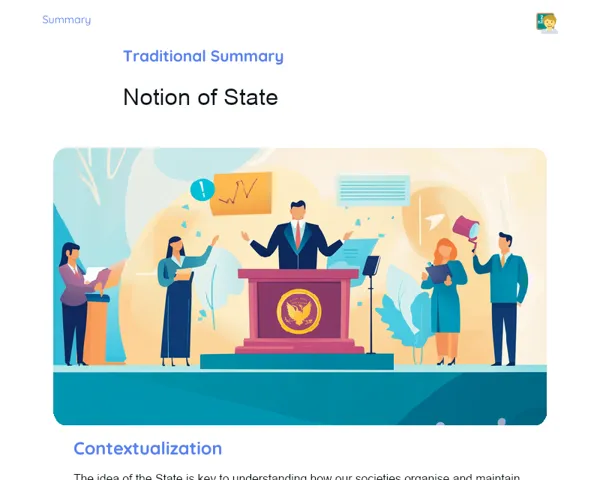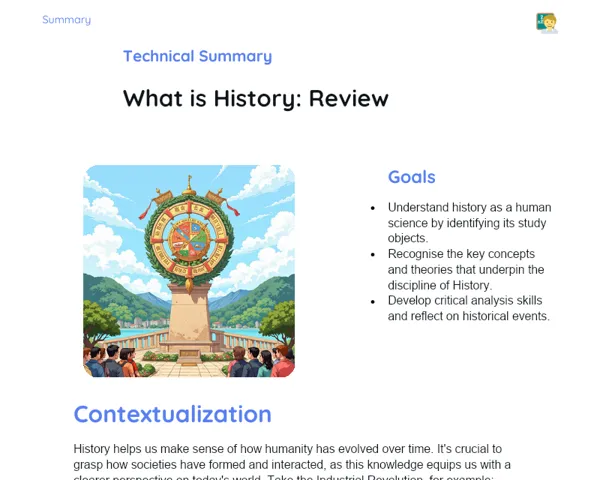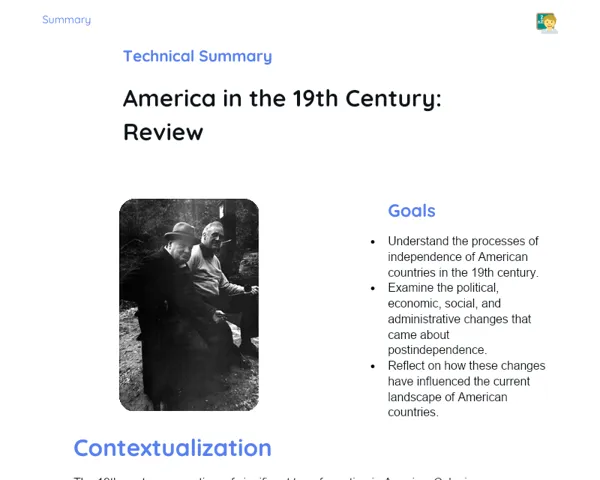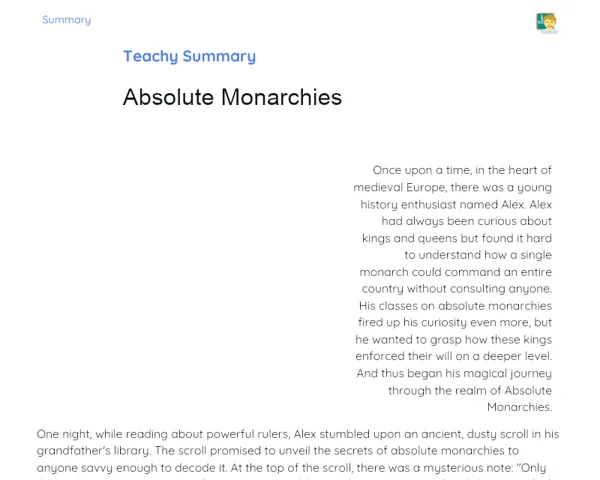Summary Tradisional | World War II
Contextualization
World War II, which unfolded from 1939 to 1945, stands as one of the most catastrophic conflicts in human history, engaging over 30 nations and resulting in millions of lives lost. This war was marked by significant battles, acts of genocide, and the deployment of nuclear weapons. It reconfigured global politics, leading to the establishment of the United Nations and ushering in the Cold War. To grasp the motivations and events that led to this conflict, it is crucial to analyse the interwar period, the rise of totalitarian regimes, and the territorial and ideological disputes that erupted globally.
The roots of World War II include the Treaty of Versailles, which placed severe penalties on Germany after World War I, breeding a sentiment of revenge among Germans. The Great Depression, which began in 1929, triggered global economic turmoil, aiding the ascent of totalitarian regimes, notably Nazism in Germany and Fascism in Italy. Japanese expansion in Asia also escalated international tensions, further contributing to the emergence of the conflict. Understanding these factors is essential for grasping the historical backdrop that led to the war’s outbreak.
To Remember!
Antecedents and Motivations
The factors leading up to World War II are crucial in understanding the underlying causes of the conflict. The Treaty of Versailles, signed in 1919, imposed severe economic and territorial penalties on Germany, creating resentment and a longing for retribution among the German populace. This feeling was deftly harnessed by Adolf Hitler and the Nazi Party, who vowed to restore Germany’s former glory and nullify the treaty’s conditions.
The Great Depression, which kicked off in 1929, wreaked havoc on world economies, leading to mass unemployment and political upheaval. In multiple countries, this economic crisis empowered totalitarian regimes that promised swift and radical remedies for socio-economic issues. In Germany, the financial turmoil swelled support for the Nazi Party, which proposed a path to recovery through aggressive expansion and militarism.
Additionally, Japan’s ambitions in Asia heightened international strain. Japan, in pursuit of natural resources, invaded Manchuria in 1931 and expanded its aggression into China and Southeast Asia. These acts of expansion not only deepened suspicion and animosity between nations but paved the path for worldwide conflict.
Grasping these antecedents is vital for contextualising the motivations that triggered World War II, emphasizing how intertwined economic, political, and territorial factors culminated in a conflict-ready environment.
-
The Treaty of Versailles imposed harsh penalties on Germany.
-
The Great Depression facilitated the rise of totalitarian regimes.
-
Japanese expansionism in Asia heightened international tensions.
Major Conflicts and Events
World War II was characterised by a succession of significant conflicts and incidents that altered the course of history. The German invasion of Poland on September 1, 1939, is generally acknowledged as the war's inception. This act of aggression compelled the United Kingdom and France to declare war on Germany, igniting the conflict in Europe.
The Battle of Stalingrad (1942-1943) stood out as a pivotal confrontation in the war. The Soviet victory here signalled the commencement of a concerted offensive against Axis forces in Eastern Europe, shifting the war's dynamics in favour of the Allies. Another landmark was D-Day, on June 6, 1944, when Allied troops landed on the beaches of Normandy, France, creating a new western front against Nazi Germany.
In the Pacific theatre, Japan's capitulation was hastened by the dropping of atomic bombs on Hiroshima and Nagasaki in August 1945. This act marked the conclusion of the war in the Pacific and cast a stark light on the harrowing realities of nuclear warfare, which would sculpt post-war geopolitics dramatically.
These events not only dictated the outcome of World War II but also left enduring effects on global politics and international relations, shaping the world as we know it today.
-
The invasion of Poland marked the beginning of the war.
-
The Battle of Stalingrad was a crucial turning point.
-
D-Day opened a new western front against Germany.
-
Atomic bombs in Hiroshima and Nagasaki precipitated Japan's surrender.
Geopolitics of the Involved Countries
World War II entailed a complicated web of alliances and geopolitical rivalries. The primary blocs formed were the Allies and the Axis Powers. The Allies comprised the United Kingdom, the Soviet Union, the United States, and China, whereas the Axis was mainly made up of Germany, Italy, and Japan.
The leadership of these nations was fundamental in the war's progression. Adolf Hitler, the leader of Nazi Germany, aimed to create an Aryan empire through territorial expansion and the eradication of undesirable groups. Winston Churchill, the Prime Minister of the United Kingdom, was pivotal in resisting Nazi Germany, while Franklin D. Roosevelt, the U.S. President, guided American efforts on both European and Pacific fronts.
Joseph Stalin, head of the Soviet Union, played an essential role in overcoming Axis forces in Eastern Europe but also played a part in the post-war tensions that ignited the Cold War. The collaboration among these leaders, despite their ideological differences, was crucial in coordinating military strategies and achieving victory over the Axis regimes.
Understanding the geopolitics of these nations provides context to the power dynamics and strategic choices that directed the flow of World War II, as well as informing the international climate of the post-war era.
-
Allies: United Kingdom, Soviet Union, United States, and China.
-
Axis: Germany, Italy, and Japan.
-
Leadership: Adolf Hitler, Winston Churchill, Franklin D. Roosevelt, Joseph Stalin.
Consequences of the War
The repercussions of World War II were drastic and widespread, impacting global politics, economies, and societies. A significant outcome was the establishment of the United Nations (UN) in 1945, aimed at fostering peace and global cooperation to avert future conflicts.
Germany’s division into occupation zones, which eventually transformed into West Germany and East Germany, symbolized the deepening rift between the Western and Eastern blocs led by the United States and the Soviet Union, respectively. This split contributed to the emergence of the Cold War, a period marked by political and military tension between the two superpowers that persisted until the late 1980s.
On the economic front, the U.S. Marshall Plan was initiated to assist in rebuilding war-torn Europe. This programme not only spurred economic recovery but also fortified Western alliances against Soviet influence. Moreover, the war hastened the decolonisation movement, with many territories seeking independence from weakened European powers.
The social and technological impacts were equally significant. World War II led to advancements in medicine, like the widespread use of penicillin, and in technology, giving birth to early computers. Socially, it also brought about increased participation of women in the workforce and bolstered the civil rights movements.
-
Creation of the United Nations (UN) in 1945.
-
Division of Germany and the onset of the Cold War.
-
Implementation of the Marshall Plan for European reconstruction.
-
Acceleration of the decolonization process.
Key Terms
-
Treaty of Versailles: Peace agreement that concluded World War I, enforcing severe penalties on Germany.
-
Great Depression: Global economic downturn that began in 1929, aiding the rise of totalitarian regimes.
-
Nazism: Totalitarian ideology spearheaded by Adolf Hitler in Germany, marked by expansionist and genocidal policies.
-
Japanese Expansionism: Aggressive national policy of Japan in Asia, pursuing natural resources and land.
-
Axis: Military and political alliance formed by Germany, Italy, and Japan during World War II.
-
Allies: Coalition of nations, including the United Kingdom, Soviet Union, United States, and China, united against the Axis powers.
-
Battle of Stalingrad: Critical confrontation between Soviet and German forces, signalling the onset of the Soviet offensive.
-
D-Day: Allied forces' landings in Normandy on June 6, 1944, that opened a new western front against Germany.
-
UN: United Nations, founded in 1945 to foster peace and international cooperation.
-
Cold War: Period of escalating political and military tension between the United States and the Soviet Union following World War II.
-
Marshall Plan: U.S. economic aid initiative for the reconstruction of Europe in the aftermath of the war.
-
Decolonization: The process of independence from European colonial rule experienced by territories in Asia, Africa, and elsewhere after World War II.
Important Conclusions
World War II was a monumental event with a profound global impact, whose roots, conflicts, and outcomes significantly influenced the modern world. Understanding the Treaty of Versailles, the Great Depression, and the emergence of totalitarian regimes is critical to contextualising the motivations that led to the war. Key events, like the invasion of Poland, the Battle of Stalingrad, and D-Day, were pivotal in steering the conflict towards the Allies’ victory.
The geopolitics of the countries involved, with the alliances between the Allies and the Axis, alongside the leadership of figures such as Hitler, Churchill, Roosevelt, and Stalin, played an instrumental role in the war’s evolution. The aftermath of the war, including the founding of the United Nations, the partition of Germany, and the onset of the Cold War, left enduring marks on global politics, economies, and societies.
Studying World War II is essential for appreciating present-day political and social dynamics. The war not only reshaped international relations but also propelled advancements in technology and medicine. Familiarising oneself with this historical period enhances our ability to interpret current events and underscores the importance of international collaboration in preventing future conflicts.
Study Tips
-
Review key events chronologically to understand the sequence and connections between occurrences.
-
Employ geopolitical maps to visualise territorial changes and military alliances throughout the war.
-
Explore biographies and primary documents of key figures like Hitler, Churchill, Roosevelt, and Stalin for deeper insight into their decisions and influences.



